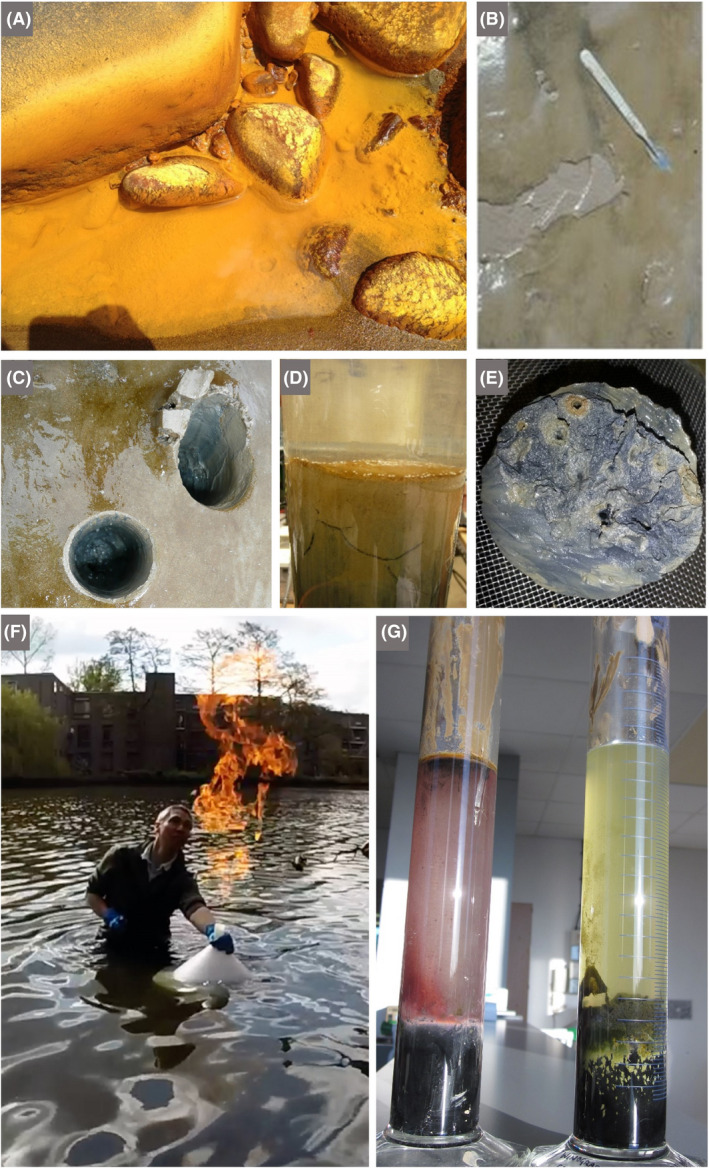Fig. 13.

Microbial manifestations of their phototrophic and reduction–oxidation activities
A. Boulder and pebbles in Río Sucio (Dirty River) in Costa Rica are coloured orange due to the presence of schwertmannite, a mineral generated by the activity of iron‐oxidizing bacteria, such a Gallionella spp., which use reduced iron as a form of energy, oxidizing it to form rusty minerals (Arce‐Rodríguez et al., 2017).
B. Peel of mudflat sediment showing a thick gelatinous biofilm rich in diatoms (silica‐walled eukaryotic phototrophic microalgae) on top of the clay‐rich sediment. Diatoms are the main primary producers in this ecosystem and, by the production of sticky extracellular polymeric substances, they stabilize the sediment, thus limiting coastal erosion.
C. Cored sediment from Tillingham mudflat, UK (holes are ~ 8 cm diameter), showing the golden mats formed by diatoms on the surface, and the transition to grey‐black sediment at depth caused by anaerobic sulfate‐reducing bacteria releasing sulfide that reacts with iron to form black iron sulfide.
D. Extracted sediment core from C, incubated in the light, showing how the diatoms and other phototrophic microbes produce bubbles of oxygen visible at the surface.
E. A transverse slice of the sediment shown in D, illustrating how burrowing animals such as the ragworm (Hediste diversicolor) can introduce oxygen deeper into the sediment and thus encourage the activity of aerobic microbes, such as iron‐oxidizing microbes, leading to a ring of rust around the holes.
F. Burning methane from the lake at the University of York, UK. The sediment was stirred to release methane bubbles (produced by anaerobic methanogenic Archaea), which were collected in a funnel and set alight. This phenomenon can occur without human assistance, with the resultant ghostly light engendering myths and legends worldwide, such as Will‐o'‐the‐Wisp and ignis fatuus.
G. Winogradsky columns set up with cellulose and sediment from an Essex salt marsh. The left‐hand column is dominated by purple sulfur anoxygenic phototrophs, while the right‐hand column is dominated by green sulfur anoxygenic phototrophs, both of which are Bacteria that use light as an energy source, but instead of splitting water and generating oxygen (as in the diatoms in D) they split hydrogen sulfide. The sulfide is produced by anaerobic sulfate‐reducing bacteria found in the black sediment. Photograph A by Max Chavarría, B by Graham J.C. Underwood, C, D, E and G by Terry McGenity and F by Paul Shields and James Chong.
